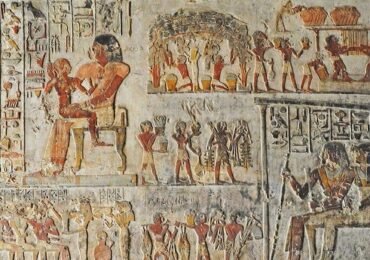The site of El-Kab, known in ancient times as Nekheb. It is located 32km (20 miles) south of Esna on the Nile’s east bank. Activity at the site spans the entirety of ancient Egyptian history and beyond, from the Predynastic period to the Coptic era. El-Kab was the cult home of Nekhbet, the vulture goddess of Upper Egypt. Who was traditionally paired with the cobra goddess of Lower Egypt, Wadjet.
El-Kab is littered with remains of temples, settlements, cemeteries, and rock-cut tombs. But the most impressive feature still visible is a massive mud brick town wall, which dates to the 30th Dynasty. Nekhbet’s principal temple at the site is found within a large mud brick enclosure wall along with additional structures, including a New Kingdom temple dedicated to Thoth, the remains of a birth house, and a small temple of Roman date, as well as a sacred lake.
Tombs of El-Kab

El-Kab was strategically located at the mouth of the Wadi Hellal. The cliffs known as the “Cliff of the Vulture” of this wadi are covered with petroglyphs and inscriptions dating from the prehistoric era through the Late Period, attesting to its importance as a route from the Nile Valley into the Eastern Desert. Located within this wadi is a temple to Hathor and Nekhbet built by Amenhotep III as well as a smaller stone chapel erected by Setau, Viceroy of Kush under Ramesses II, probably dedicated to Re-Horakhty, Hathor, Amun, and Ramesses II. Both temples were restored during the Ptolemaic Period.
How to get to El-Kab from Luxor?
To reach El-Kab from Luxor, you can choose from the following options:
1. By Taxi
- Distance: El-Kab is approximately 85 kilometers (53 miles) south of Luxor on the east bank of the Nile.
- Duration: A private car or taxi will take about 1.5 hours to get there.
- Tips: Arrange a ride through your hotel or a local tour operator. This option provides flexibility and comfort.
2. By Train
- Option: Take a train from Luxor to the El-Kab (Edfu) train station, which is located near the site.
- Duration: The train ride takes approximately 1.5 hours.
- Tips: Check the train schedules in advance and ensure the train stops at Edfu, the nearest station to El-Kab.
3. By Public Minibus
- Option: Use minibuses heading to Edfu or nearby villages.
- Duration: The trip might take about 2 hours, depending on stops.
- Tips: Be prepared for a less comfortable journey compared to private options.
4. By Guided Tour
- Egypt Best Vacations offers day trips to El-Kab as part of historical excursions.
- Benefits: Includes transport, guides, and a comprehensive visit to the tombs and temples of El-Kab.
Important Notes for Visiting El-Kab
- Timing: Visit in the morning or late afternoon to avoid midday heat.
- What to See: Explore the tombs, temples, and ancient ruins, including the impressive tomb of Ahmose, Son of Ibana.
- Preparation: Bring water, sunscreen, and comfortable walking shoes.
Enjoy exploring this hidden gem, rich with ancient Egyptian history and culture!

